Click on images to enlarge

habit (Photo: Sheldon Navie)
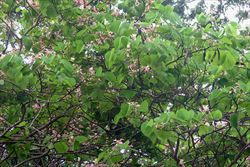
habit in flower (Photo: Sheldon Navie)
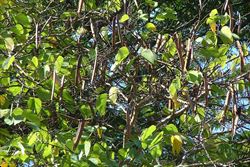
habit when beginning to lose its leaves in autumn (Photo: Sheldon Navie)
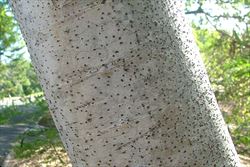
bark of main trunk (Photo: Sheldon Navie)
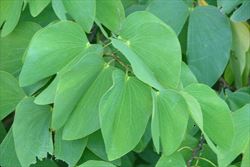
leaves (Photo: Sheldon Navie)
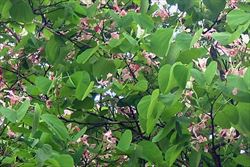
flowers (Photo: Sheldon Navie)
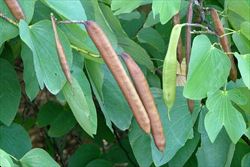
immature and mature fruit (Photo: Sheldon Navie)
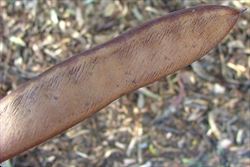
outside of old fruit (Photo: Sheldon Navie)
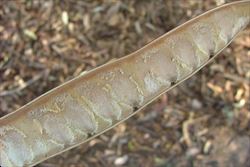
inside of old fruit (Photo: Sheldon Navie)
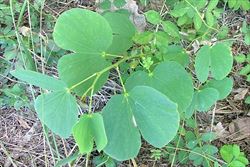
seedling (Photo: Sheldon Navie)
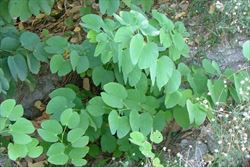
young plants (Photo: Sheldon Navie)
Scientific Name
Bauhinia monandra Kurz
Synonyms
Bauhinia persiehii F. Muell.
Family
Caesalpiniaceae (Queensland, the ACT, Victoria, Tasmania, Western Australia and the Northern Territory)Fabaceae: sub-family Caesalpinioideae (New South Wales)Leguminosae (South Australia)
Common Names
butterfly flower, Jerusalem date, Napoleon's plume, orchid tree, orchidtree, pink bauhinia, pink butterfly tree, pink orchid tree, pink orchid-tree, St. Thomas tree
Origin
Native to Madagascar. In the past the origin of this species was unknown, and it has erroneously been described as originating from south-eastern Asia (e.g. Myanmar) and tropical South America.
Cultivation
This species is commonly cultivated as a garden and street tree in the tropical regions of Australia.
Naturalised Distribution
Commonly naturalised in the Cook pastoral district in far northern Queensland (e.g. in the Coen, Lockhart River, Cooktown and Mareeba areas). Also reported to be naturalised as far south as Townsville in the North Kennedy pastoral district.
Also naturalised on Christmas Island, in the Caribbean, in southern USA (i.e. Texas and Florida) and on numerous Pacific Islands (e.g. American Samoa, Western Samoa, Tonga, Pagan Island, Tinian Island, Cook Islands, French Polynesia, Niue and Hawaii).
Habitat
A weed of drier sites with relatively poor soils and has also been observed to grow on river levees and in dense riparian vegetation (i.e. along waterways).
Habit
A small tree (growing up to 7.5 m tall) which loses its leaves during the dry season (i.e. it is deciduous).
Distinguishing Features
- a small tree that usually loses its leaves during the dry season.
- its simple leaves have two lobes and are folded in the centre (i.e. they resemble a pair of butterfly wings).
- its showy flowers have five pinkish petals mottled with darker reddish-purple, one of which is more colourful than the others.
- its fruit is a large, elongated, pod (15-22 cm long).
Stems and Leaves
The older stems are covered with a smooth grey coloured bark. These stems are also covered with numerous small darker spots (i.e. lenticels). Younger stems are almost hairless (i.e. glabrescent) or have some rusty coloured hairs (i.e. rusty pubescent).
The simple leaves (7-20 cm long and 7-20 cm wide) are alternately arranged along the stems and borne on stalks (i.e. petioles) 4-6 cm long. They have somewhat heart-shaped (i.e. sub-cordate) bases and are split at the tips into two lobes, with the split usually being quite shallow (sometimes almost halfway to base). They are also folded along the central vein (i.e. midrib) and therefore appear similar to a pair of butterfly wings. These leaves have hairless (i.e. glabrous) upper surfaces, but their are usually some hairs present along the veins on the their undersides.
Flowers and Fruit
The flowers are borne in small clusters in the leaf forks (i.e. in short axillary racemes) and individual flowers have very short stalks (i.e. pedicels) only 2-5-4 mm long. These flowers have five large, spreading, petals (each about 40-55 mm long and 20-30 mm wide) and a single large curved stamen (there are usually also five tiny rudimentary stamen-like structures present, about 3 mm long, which are called staminodes). The sepals (15-22 mm long) are fused into a green tube (i.e. calyx tube) that is hairy (i.e. pubescent) and splits open on one side when the flower opens. Four of the petals are similar while the other petal is different (i.e. the petals are dimorphic). The four similar lower petals are pale pink or whitish, mottled with numerous tiny darker reddish-pink or purple spots, and are wider nearer their tips (i.e. obovate). The single upper petal is often somewhat yellowish in colour, with more prominent reddish coloured markings, and is usually wider nearer its base (i.e. ovate). Flowering occurs during late spring and summer (i.e. from October to January).
The fruit is a large, elongated, and flattened pod (15-22 cm long and 2-3 cm wide) containing about 10-20 seeds. These fruit are somewhat leathery in nature and pale brown to dark brown in colour. The seeds (about 10 mm long long) are flattened (i.e. compressed), egg-shaped in outline (i.e. ovate), and either dull brown or black in colour. Fruit are present from summer through to spring (i.e. from January to October).
Reproduction and Dispersal
This species reproduces by seed. Its seeds are spread when they are ingested and expelled by birds and other animals. They are also dispersed by water, particularly from ornamental plantings located near waterways, and in dumped garden waste.
Environmental Impact
This species is regarded as an environmental weed in northern Queensland and is included in the Far North Queensland Priority Weed List. It is a medium priority pest plant in the Cook Shire, where it has invaded open woodlands, forests and conservation areas (e.g. Lakefield National Park).
It has also invaded disturbed forests and drier sites on several Pacific islands (i.e. on Tinian in the Northern Mariana Islands and in the Galápagos Islands).
Legislation
Not declared or considered noxious by any state government authorities.
Similar Species
Bauhinia (Bauhinia monandra) is very similar to closely related introduced species such as Bauhinia variegata, Bauhinia purpurea and Bauhinia galpinii (all of which have occasionally become naturalised in some parts of Queensland). These species can be distinguished by the following differences:
- bauhinia (Bauhinia monandra) is a small tree with relatively large leaves (up to 20 cm wide). Its flowers are pale pink or whitish with darker pink or reddish-purple markings and have a single fertile stamen.
- butterfly tree (Bauhinia variegata) is a small tree with relatively large leaves (up to 15 cm wide). Its flowers vary from entirely white to various shades of pink or purple with darker pink or reddish-purple markings and have five fertile stamens.
- purple bauhinia (Bauhinia purpurea) is a small tree with relatively large leaves (up to 20 cm wide). Its flowers vary from pale purple to bright pinkish-purple and have three fertile stamens.
- red bauhinia (Bauhinia galpinii) is a large shrub, sometimes climbing over other vegetation (i.e. a scandent chrub), with relatively small leaves (less than 10 cm wide). Its flowers vary from dark orange to scarlet or dark red and have three fertile stamens.
There are also some "native bauhinias" (i.e. Lysiphyllum spp.) present in northern Queensland. However, these species can be distinguished by their leaves having two separate leaflets, instead of being two-lobed.

